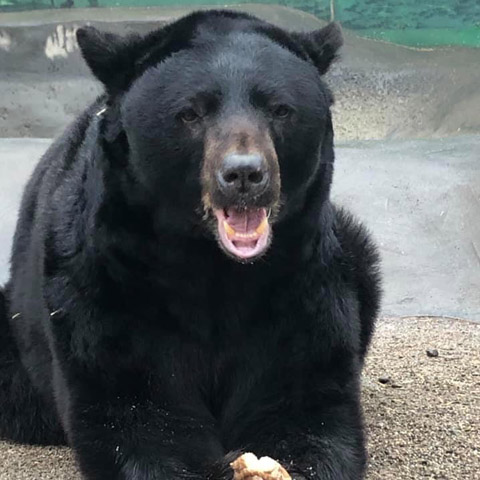American Black Bears – Oscar & Oso
(Ursus americanus)
Meet Oscar and Oso
Our two American black bears, Oscar and Oso, have very different beginnings but share one heartwarming story of resilience and second chances. Both came to Cat Tales Wildlife Center after being rescued from unsafe or illegal situations, and now they live out their days in a naturalistic, enriching habitat designed just for them. Together, they serve as ambassadors for wild bears everywhere—helping visitors understand the challenges these incredible animals face and the importance of peaceful coexistence.
Oscar – The Gentle Soul
Born in February 2003, Oscar was found as an abandoned cub rummaging through trash near an old garage in Deer Park, WA. Too young to survive on his own and not a candidate for rehabilitation, he found his forever home here at Cat Tales before his first birthday.
Though technically a black bear, Oscar’s cinnamon-colored coat often surprises visitors and sparks discussions about the diverse color variations within his species. Today, he enjoys lazy days basking in the sun, nibbling on fruit, and showing off his calm nature. Oscar’s story reminds us how habitat encroachment and unsecured garbage can quickly turn deadly for wild bears—and how education can help prevent those conflicts.

Oso – The Survivor
Oso, whose name means “bear” in Spanish, was born in February 2004 and arrived at Cat Tales in early 2005. His early life was far from natural—kept illegally as a pet and found malnourished in a bathtub, weighing only 20 pounds. After being rescued and brought to Cat Tales, Oso received the care, nutrition, and space he needed to heal and grow.
Now a strong, playful bear, Oso can often be seen splashing in his pool, rolling pumpkins, or scratching his back against gates and logs. His boundless curiosity and appetite make him a visitor favorite, but his story carries a serious message about the consequences of keeping wild animals as pets.

Black bears are intelligent, adaptable, and curious by nature—but those same traits can get them into trouble when human development overlaps with their territory.
- Wild Instincts: Bears are driven by powerful instincts to forage, roam, and defend territory. These behaviors can never be “trained out” and make them unsafe as pets.
- Dietary & Space Needs: A wild bear can roam up to 50 square miles, consuming fruits, roots, insects, and small prey. Meeting those needs in captivity requires expert care and habitat design.
- Human Impact: Food-conditioned bears are often euthanized for safety reasons, making education about bear behavior and proper waste management critical for coexistence.
At Cat Tales, Oscar and Oso live in a habitat that allows them to dig, climb, forage, and cool off in pools, simulating the behaviors that keep them physically and mentally healthy.
- Wide Range of Colors: Despite their name, black bears can be black, brown, cinnamon, or even blonde.
- Omnivorous Diet: They eat berries, nuts, vegetation, insects, and occasionally small animals—playing an important role in seed dispersal and ecosystem balance.
- Incredible Sense of Smell: A black bear’s nose is seven times stronger than a bloodhound’s, helping them find food from miles away.
- Adaptable Survivors: From coastal rainforests to mountain peaks, black bears thrive in diverse habitats across North America.
Black bears are listed as a species of Least Concern, with populations remaining stable in much of North America. However, habitat loss, vehicle collisions, and conflicts with humans pose increasing threats.
At Cat Tales, our bears help share the message of “Conservation through Education”—encouraging people to respect wildlife and support healthy ecosystems.
- Enrichment & Play: Keepers create daily enrichment activities—from puzzle feeders and hidden snacks to water play—to encourage natural behaviors.
- Seasonal Changes: In summer, Oscar and Oso enjoy cool pools and frozen fruit treats. In winter, they slow down and spend more time resting in cozy dens with extra straw bedding.
- Care & Observation: Our team monitors their diets, activity levels, and seasonal weights, ensuring both bears remain healthy and active well into their senior years.


